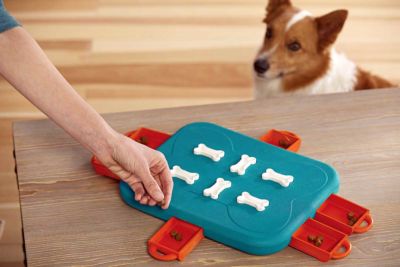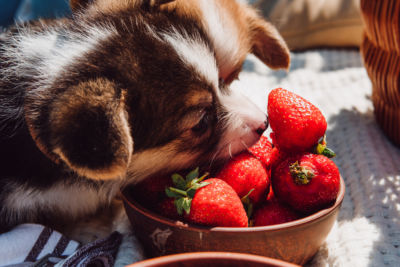
In 1989, a breeder decided to blend the genetic material of a poodle and a Labrador retriever to see what would happen. The result was the Labradoodle, an affectionate companion dog that quickly rose in popularity. Their sweet, sociable natures and high intelligence levels make them the perfect family pets, and their hypoallergenic and low-shedding coats ensure they fit well into any home.
Although every Labradoodle has its own unique needs and interests, these dogs are typically active and energetic. In addition to 30 to 60 minutes of exercise per day, a Labradoodle diet needs to be nutritious and fulfilling to guarantee their health and happiness.
The Importance of a Good Labradoodle Diet
Just like people, dogs require healthy meals to function in their day-to-day lives. High-quality, healthy food expands a dog’s lifespan and helps repair body tissues, satisfy energy levels and strengthen both the immune system and the digestive system. Malnourished dogs are more susceptible to health issues, such as:
- Obesity
- Emaciation (unnatural thinness)
- Rickets (weakening of bones)
- Heart disease
- Joint problems
- Diabetes
A poor diet can shorten a dog’s lifespan by over two years, and it can result in higher veterinary bills. Thus, it’s important to thoroughly understand your Labradoodle’s diet needs and provide good dog food that meets those needs.
Labradoodle Nutritional Needs
 When it comes to feeding your Doodle, it’s important to make sure it’s getting all the necessary nutrients for its breed and body weight. You must also consider its age. Keep in mind that a Labradoodle puppy becomes an adult Labradoodle between the ages of 12 and 18 months and will remain an adult until around 10 years of age. The typical the best dog food for Labradoodle adult dog requires:
When it comes to feeding your Doodle, it’s important to make sure it’s getting all the necessary nutrients for its breed and body weight. You must also consider its age. Keep in mind that a Labradoodle puppy becomes an adult Labradoodle between the ages of 12 and 18 months and will remain an adult until around 10 years of age. The typical the best dog food for Labradoodle adult dog requires:
- 18% protein
- 5% fat
- Complex carbohydrates
- Fiber
- Vitamins, minerals and antioxidants
- Omega-3 and omega-6 fatty acids
Labradoodle puppies, those younger than 12 to 18 months, generally require higher levels of protein and fat to accommodate their growth. Senior dogs also need high-protein foods to help fuel muscle. Other factors to consider include size and activity level. Large, high-energy adult dogs require more calories to make up for the amount they’re burning. However, no matter how old, large or energetic your dog is, you should always look for a healthy combination of these materials when planning a dog’s diet.
Recommended Food for Labradoodles
With all the different dog food brands and diets out there, it’s normal for most dog owners to feel overwhelmed by the options. Understanding the different kinds of food available and the respective pros and cons will help you make the best decision for your dog.
Commercial Dog Food
When it comes to convenience, commercial dog food can’t be matched. It requires minimal effort to prepare, but commercial brands offer clear instructions on which dog breeds benefit from their food. Most brands also provide different foods for different ages and sizes, which helps dog owners easily transition from puppy food to adult food. Thus, commercial dog food brands are a fairly popular option when it comes to feeding pets. However, some people swear that commercial brands load their food with unhealthy, subpar ingredients and insist they can’t meet the nutritional requirements of dogs. The truth is, commercial food can meet all your dog’s needs — provided you select the right one.
 The tools you need to evaluate a dog food brand are typically available right on the packaging. The most important thing to check when purchasing kibble is the first ingredient listed on the packaging. In high-quality food, you can expect meat to be the primary ingredient. Conversely, lower-quality foods contain high amounts of meat by-products, such as chicken meal. They also often contain cornmeal, soy and other unhealthy ingredients that can promote health problems.
The tools you need to evaluate a dog food brand are typically available right on the packaging. The most important thing to check when purchasing kibble is the first ingredient listed on the packaging. In high-quality food, you can expect meat to be the primary ingredient. Conversely, lower-quality foods contain high amounts of meat by-products, such as chicken meal. They also often contain cornmeal, soy and other unhealthy ingredients that can promote health problems.
Another factor to consider is whether the dog food features a statement from the Association of American Feed Control Officials (AAFCO). This label sets high standards for U.S.-manufactured pet foods and ensures the food meets all nutritional needs. In general, AAFCO-recommended brands should be selected over ones that have not received their stamp of approval.
Finally, dog owners need to choose between dry dog food and wet canned food. Dry kibble is usually the recommended option as it has higher protein levels and is better for digestion. Dry food also encourages dental health and helps maintain good breath. However, it’s always advisable to keep some wet food on reserve. Wet food is typically easier to digest and can help with hydration, so many dog owners choose to mix it in with dry dog foods every now and then.
Raw Diet
A raw food diet is one of the most controversial dog food options out there. Advocates of this diet argue that it promotes overall canine health, but disbelievers claim the bacteria found in raw materials can be dangerous. Ultimately, it’s best to consult your veterinarian before starting your dog on a raw diet.
The main advantage of raw food diets is that, unlike with commercial dog foods, owners know exactly what’s going into their dog’s food — there’s no need to worry about fillers or artificial preservatives. Most raw food advocates follow the BARF (Biologically Appropriate Raw Food) diet, which consists of good-quality meat, vegetables and healthy carbs (like sweet potatoes or brown rice). It typically also includes organs (such as liver, kidney or spleen), as well as some extra ingredients to optimize a balanced nutrition and flavor (such as herbs or fish oil).
While there are subscription services available for raw diets, many dog owners choose to make the food themselves. It’s important to handle and prepare these meals carefully to avoid the risks associated with raw foods, like salmonella and infections.
Fresh Diet
 Dog owners who want the benefits of raw diets without the risks may opt to feed their dog a fresh food diet. Like raw diets, these foods are all-natural and include a healthy combination of proteins, carbohydrates, vegetables and organs. However, unlike raw diets, a fresh diet ensures all meats are cooked thoroughly. While these diets require more effort and tend to be on the pricier side, they let dog owners monitor ingredients without having to worry about unhealthy bacteria.
Dog owners who want the benefits of raw diets without the risks may opt to feed their dog a fresh food diet. Like raw diets, these foods are all-natural and include a healthy combination of proteins, carbohydrates, vegetables and organs. However, unlike raw diets, a fresh diet ensures all meats are cooked thoroughly. While these diets require more effort and tend to be on the pricier side, they let dog owners monitor ingredients without having to worry about unhealthy bacteria.
Another food option involves combining different types of diets. Many dog owners give their dogs a steady combination of dry, hard kibble with fresh veggies and meats, simultaneously reaping the benefits of dry and fresh dog food. It’s also a good idea to include some probiotics to promote your dog’s immune system health and prevent gastrointestinal issues. You can consult your vet for recommendations on health supplements.
Food Allergies
While there are some general guidelines you can use when it comes to feeding your dog, it’s important to remember that every dog is different. Some Labradoodles may have food allergies that affect the type of diet they can consume.
If you notice any food allergy symptoms, such as rashes or reddened skin, you should try to identify the culprit as quickly as possible. A good way to test for allergies is to conduct an elimination diet. This requires getting rid of certain foods and then slowly reintroducing them one by one to see if your dog has some type of reaction. Before starting the elimination diet, you should examine the most likely causes of your dog’s allergy. Common canine allergies include:
- Beef
- Chicken
- Wheat
- Dairy
- Eggs
- Soy
Feeding your dog ingredients it’s allergic to will make it uncomfortable, but it can also lead to greater issues such as secondary skin infections and poor behavior. If you notice that your Labradoodle is allergic to a certain meat, simply switch the protein source. If it has a negative reaction to wheat and gluten, you should give it grain-free dog food. Dogs with a high amount of allergies may benefit more from homemade meals where every ingredient can be carefully monitored.
Food Quantities
Most commercial dog foods come with instructions to guide owners through feeding, with the general recommendation being 1.5 to 2 cups of kibble a day (split between two meals). However, if you’re making your own food, this can be tricky.
The central factors to consider when you feed your Labradoodle are life stages and size. The quantities for adult food are consistent, but the quantities for puppy foods change every month. Moreover, larger dogs with higher body weights eat more than smaller dogs. While there are many Labradoodle feeding charts available online, you should consult your veterinarian about feeding quantities just to be safe. Giving your dog the right amount of food is the key to maintaining a healthy weight and promoting overall wellness.

Feeding Your New Best Friend
What’s the best diet for Labradoodles? There’s no single answer. Ultimately, you want a diet that’s right for your dog’s age and size and accommodates its allergies and health needs. The better the food, the happier the dog!
At Pride & Prejudoodles, we start all our Labradoodles for sale on a healthy, nutritional diet and specific feeding schedule. We also monitor our dogs to ensure the diet supports their nutrition and doesn’t cause any allergies or health issues. Whenever someone gets a Labradoodle through us, we send along the food we use at no additional cost. If you choose to change your dog’s diet, be sure to transition it to the new food gradually and revert back if you notice any problems. Contact us today to learn more about our Labradoodles and dietary recommendations!
